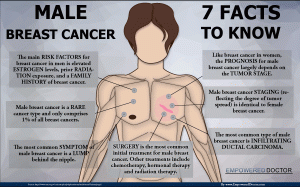NEWS AND UPDATES
The Truth about Male Breast Cancer
Male breast cancer is rare, but it happens.
The International Agency for Research on Cancer (IARC) of the World Health Organization (WHO) states that breast cancer is the most usual cause of cancer deaths among women with more than 500,000 deaths in 2012. In the recent estimates, one in 1000 men has the risk of getting the disease. In the Philippines, it is the most common disease for both sexes combined, according to the Philippine Cancer Society (PCS).
“All people, whether male or female, are born with some breast cells and tissue. Even though males do not develop milk-producing breasts, a man’s breast cells and tissue can still develop cancer,” National Breast Cancer Foundation explained. Breast cancer usually develops in the lobules (lobular carcinoma) or ducts (ductal carcinoma), the most common type in males.
According to the Centers for Disease Control and Prevention (CDC), breast cancer can have varying symptoms to none at all. Symptoms of breast cancer in males are similar to that of females that may include lump in breast or underarm, change in size or shape of the breast, redness of breast skin and nipple discharge.

The risk of men getting cancer goes up with age, mostly between 60 to 70 years old. However, chances of getting the disease can also be attributed to family history, radiation exposure, alcohol consumption, and obesity.
To reduce the risk of getting breast cancer, CDC advised to eat healthful diet, exercise regularly, get enough sleep, limit alcohol intake and reduce radiation exposure.
PCS, on the other hand, stressed the importance of early diagnosis like breast self-exam (BSE), clinical breast exam (CBE) and mammograms, x-ray picture of the breast.
“Anyone who notices anything unusual about their breasts, whether male or female, should contact their physician immediately…Early detection of breast cancer increases treatment options and often reduces the risk of dying,” National Breast Cancer Foundation emphasized.
October is the National Breast Cancer Awareness Month. For more information about the disease and its status in the Philippines, you may read http://www.philcancer.org.ph/wp-content/uploads/2014/06/Breast-Cancer-Awareness-Oct-Campaign.pdf. Detailed information about male breast cancer can be accessed at http://www.cancer.org/acs/groups/cid/documents/webcontent/003091-pdf.pdf.■




